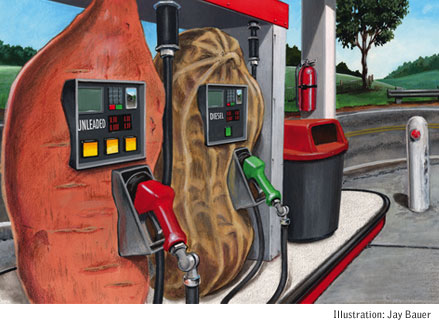


Turning Timber Into Black Gold
by Susan Varlamoff
Intro
| Running with a Simple Idea
| Transforming the State, the Country, and the Century

![]()
Running with a Simple Idea
Using biofuels for energy is not avant-garde. In the 19th century, fish and whale oils were used for heat and light. Henry Ford, who descended from farmers, envisioned ethanol (a type of alcohol, made from biomass) to fuel his first cars. About 100 years ago, Rudolf Diesel used peanut oil to demonstrate the engine that bears his name.
Drawing inspiration from their predecessors, UGA engineering faculty and an interdisciplinary group of colleagues are developing a pilot-scale biorefinery on campus that can process different types of biomass — agricultural and forest waste, for example — into multiple products such as ethanol, hydrogen, bio-oils and char (a product similar to charcoal). A UGA-led consortium of universities, federal labs, and companies is operating the facility.

In the 1980's, UGA buses were fueled by diesel made from peanut oil. In 2006, the university will again take steps to make the fleet environmentally friendly again.
Biorefinery technologies not only provide alternatives to fossil fuels but also emit smaller amounts of atmosphere-warming carbon dioxide, said K.C. Das, a professor of engineering and coordinator of UGA’s Biorefining and Carbon Cycling Program. “The biorefinery actually sequesters carbon,” Das said, keeping it out of the air altogether.
The researchers began with a simple idea: despite the chemical differences between hydrocarbons (such as coal and oil) and carbohydrates (complex sugars found in plants), both types of materials contain carbon, the essential ingredient for fuels. “We realized,” said Das, “that all we’re missing is a process that can mimic nature’s ancient conversion of biomass to fossil fuel.”
In that spirit, they have been adopting an old coke-manufacturing technique, called pyrolysis, to transform biomass into renewable biofuels [see sidebar on page 27]. “You basically take peanut hulls, say, and heat them to 450-500 degrees Celsius,” Das said. “In the absence of oxygen, the cellulose decomposes and forms oil. It looks a lot like engine oil, but it’s a little more viscous.” Meanwhile, the product is carbon-neutral: it doesn’t add any more carbon to the atmosphere than what the biomass from which it came took up during plant growth.
Other bio-oils created in the high-temperature process can be collected for a variety of non-fuel products such as flavorings and adhesives. In addition, UGA researchers are engineering porous char, another byproduct of pyrolysis, which can be used to remove sulfur, nitrogen and carbon dioxide — all contributors to global warming — from industry smokestacks.
Intro
| Running with a Simple Idea
| Transforming the State, the Country, and the Century
For comments or for information please e-mail: rcomm@uga.edu
To contact the webmaster please email: ovprweb@uga.edu
![]()